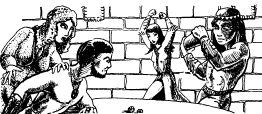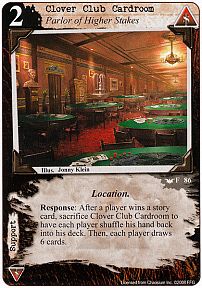
"simply use an abstract,
dice-rolling
system. The games
pay twice the
amount wagered by
the player, but the
player will only
win 25% of the time."
(A1-4.100)

"simply use an abstract,
dice-rolling
system. The games
pay twice the
amount wagered by
the player, but the
player will only
win 25% of the time."
(A1-4.100)
|
|
|
|
|
|
|
|
|
|
|
|
|
|
|
|
|
|
|
|
|
|
|
|
|
|
|
|
|
|
This pastime is common in all taverns,
inns, and just about any barracks.
You may, of course, make up any games
for wagering purposes you wish.
Here are some few for those of you who
are unfamiliar with basic dice
games. Cards are too involved to go into
here except as noted.
Other gambling games can be devised on principles of colors, shapes, position or whatever.

Craps: The shooter
wins on a first roll (2d6) of 7 or 11, or loses on 2, 3, or 12.
Otherwise the shooter rolls until the
number first rolled is rolled a second time - a win - or a 7 is rolled
- a loss.
Shooters bet before rolling, as others
may.
Side bets may be made thereafter as applicable,
if there are takers.
(The fancy line play of modern casinos
is ignored.)
Dice pass clockwise to next player when
the shooter loses.
Horse:
The first roller is determined by whatever means is desired.
5d6 are used, 6 high, 1 low.
Lowest to highest hands are: pair, two
pair, three of a kind, straight (1-5 or 2-6), full house (triplet and pair),
four of a kind, five of a kind.
The first roller may elect to roll once
or twice. If only once, all
other players may roll only once to beat
him or her. If two rolls are made,
the roller may retain none, one, two,
three, or four of the dice of the first
toss, rolling the remainder. Winner becomes
the “boss” -first roller.

Zudrak wrote:
You mean Yahtzee? :)

None other ![]()
Of course poker dice don't count, even though I used to win a lot of free drinks playing "horse"...
Heh,
Gary
Knucklebones:
Again, this is a crap-type game,
but the object is to score the highest
total.
A variant allows a second roll of the
dice by the first shooter,
retaining none or one of them, if he or
she so desires,
but then all other players are entitled
to do the same.
Winner rolls first.
Q: Numerous modules
refer to a game called knucklebones. How
is this played in terms
of the AD&D game?
A: See the DMG,
Appendix F, for a brief description of gambling
games that could be used
within a scenario.
(76.64)
Slot Variant: Use
3d6, one roll only, the wager being made prior to the
roll. The table below is weighted in favor
of the “house”. You may, of
course, devise your own tables:
<use gifs>
| - | PAYS | - |
| 6-6-1 | 2-1 | 1 = LEMON |
| 6-6-2 | 3-1 | 2 = ORANGE |
| 6-6-3 | 4-1 | 3 = BAR |
| 6-6-4 | 5-1 | 4 = BELL |
| 6-6-5 | 6-1 | 5 = PLUM |
| 1-1-1 | 4-1 | 6 = CHERRIES |
| 2-2-2 | 8-1 | |
| 3-3-3 | 10-1 | |
| 4-4-4 | 12-1 | |
| 5-5-5 | 24-1 (little jackpot) | |
| 6-6-6 | 36-1 (big jackpot) |
Zowie Slot Variant:
Use 3d8 instead of 3d6. The odds on any given
combination are changed from 1 :216 to
1 :512. Payoffs are as follows:
<use gifs>
| 6-6-1 | PAYS | |
| 6-6-2 | 2-1 | 1 = LEMON |
| 6-6-3 | 4-1 | 2 = ORANGE |
| 6-6-4 | 6-1 | 3 = BAR |
| 6-6-5 | 8-1 | 4 = BELL |
| 6-6-6 | 10-1 | 5 = PLUM |
| 6-6-7 | 12-1 | 6 = CHERRIES |
| 6-6-8 | 15-1 | |
| 1-1-1 | 8-1 | |
| 2-2-2 | 12-1 | |
| 3-3-3 | 14-1 (little jackpot) | |
| 4-4-4 | 16-1 (big jackpot) | |
| 5-5-5 | 20-1 | |
| 6-6-6 | 24-1 | |
| 7-7-7 | 50-1 | |
| 8-8-8 | 100-1 |
Dice Racing: Use
a checker board. Four players maxlmum place their
tokens on alternate rows. The object is
to move the token to the end of the
board, sideways one, and then back on
the adjacent file to the first row. A
roll of d6 determines the number of spaces
each player moves. Wagers are
to be made prior to commencement of game.
In Between: Roll
3d20 - 2 white and 1 of a different color. The player
must roll in between the 2 white dice
with the colored die. Equaling a
number is a loss. If the 2 white dice
equal each other, the loss is automatic.
Odds are always 5:2 before dice are cast.
Note: A crooked house might
point 1 1 sides of a die black ond only
9 red.

Twenty-one: A 52
card deck is used, each player betting against the
"house" dealer (the DM). Two cards are
dealt to each player and the
dealer. Players in turn elect to take
additional cards up to a total of five.
Hands totalling over 21 automatically
lose, hands of five cards under 22
automatically win double their wager (exception:
dealer).
The object is to come as close to 21 as
possible. Ties go to the "house".
Aces count either 1 or 11 at the holding
player's option, face cards count as
10, and numbered cards are as marked.
Players get first two cords down;
others are dealt face up. Dealer gets
second card face up. Dealer must take
a hit (additional card) on any total under
17, and cannot take a card on
any total of 17 or better. (This rule
is not per Hoyle.) Dealer gets cards last, <gif/link for hoyle? black
text to retain search integrity?>
bets are made after the first two cards
are dealt around. If a player has a
natural pair he or she may elect to "go
double", flipping them up, asking
for two additional face down cards (one
for each face up card), and betting
on each hand. The "house" always retains
the deal.
High-low: Each
player gets two cards face down. Prior to dealing some
stake is placed in the pot. After looking
ot the cords, each ployer turns one
up, and the player with the highest up
card bets. (A three raise limit is suggested.)
Each player has the option of changing
his or her up or down card
for a fresh one from the deck. This takes
place three times going around
the toble, with a betting interval after
each round. A 2 is low, an ACE is
high. The obiect is to have the highest
hand (0 pair on down) to a 2-3
(lowest possible hand, followed by 2-4,
3-4, 2-5, 3-5, 4-5, 2-6, 3-6, 4-6, 5-6,
2-7, and so forth). High and low hands
split the pot equally, odd money
going to high.
<moved last sentence>
<saloon doors gif? link to ...>
Quote:
Originally Posted by haakon1
Wait, are you claiming to
be a gaming genius, Mr. Gygax? That sort of talk will get you banned from
Vegas! ![]()

Noppers...I let my work
and those that enjoy it speak in that regard. I do enjoy some jesting though <big
grin>
Besides, I have a great antipathy
for Las Vegas and its gambling ![]()
![]()
Gary
